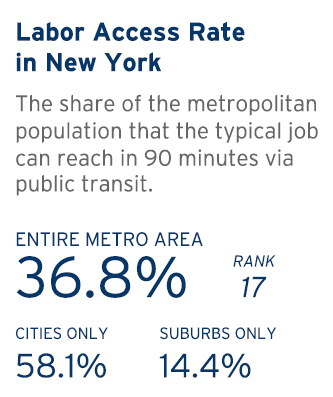
As if the need for improved transit connectivity in the New York metropolitan suburbs wasn’t clear enough already, a recent Brookings Institution study [pdf] suggests that poor transit connections are taking a toll on suburban businesses. The report lends new urgency to the need for a more robust suburban transit network.
While employers in New York’s five boroughs and Newark enjoy good access to the region’s labor pool, with nearly 60% of city jobs conveniently transit-accessible, only 14.4% of the labor pool can reach the typical suburban job in less than 90 minutes on transit [pdf], according to the study. With recent cuts to Nassau County’s bus system, a Suffolk County bus transit network that lacks adequate Sunday service, and a state that has yet to commit to transit in the congested I-287 corridor, it comes as no surprise that New York’s city-suburb transit accessibility gap is the worst in the nation. Simply put, the disconnect between where people live and where the jobs are makes it more difficult to do business in the suburbs of New York City.
This poor transit access to the labor pool can lead to higher costs for businesses. The congestion brought by an auto-borne workforce puts freight and delivery trucks in traffic, leading to increased expenses. While every workplace is accessible by car, businesses may have to raise compensation to offset the relatively high costs of automobile commutes [pdf]. Congestion and long commutes can also cause unreliability and headaches for employees, which lowers productivity and further impacts businesses’ bottom lines. Not mentioned in the study, but in line with its findings, is the fact that limited access to the labor pool also limits the employee skill set and compensation levels that businesses can choose from. Along with increased costs, this puts suburban businesses at a competitive disadvantage to firms in the urban core.
The study puts our region in touch with a hard truth: much of the New York metro area’s transportation infrastructure has yet to be updated to meet the challenges of the 21st century. Nowhere is this more true than the Hudson Valley, as evidenced by daily traffic jams on the Tappan Zee Bridge. The Hudson Valley region has one of the highest rates of vehicle miles traveled in the nation, and 50% of workers travel out of their home county to get to their job [note: a previous version of this post incorrectly stated that the Hudson Valley had the highest daily vehicle miles traveled in the nation. For a Brookings Institution ranking of metro area VMT, click here]. With a 5.1% growth rate, more than double the statewide average, the Hudson Valley faces the highest growth rate in New York State [pdf]. Unless the state adds transit to the region, the already clogged roadways will see even more traffic.
Evidence indicates that businesses in the Hudson Valley are already choosing to locate in areas with better transit options, but solving the problem requires serious improvements to the region’s infrastructure. Unfortunately, the uncertainty surrounding the state’s commitment to transit in the I-287 corridor means that business owners and workers must continue to fight for greater transportation choice.

[…] Without Transit, Access to Jobs in the Hudson Valley Will Remain Dismal (MTR) […]
[…] as it did during the original study process, to plan a corridor with transit, one that will help the Lower Hudson Valley’s economy and improve its residents’ quality of life. July 26th, 2012 | Category: Hudson Valley, New York, […]
[…] in places like Jersey City and Hoboken, Long Island has not seen as much growth. Previous studies have also shown the transit gap in New York City and its suburbs has hindered job access in the […]